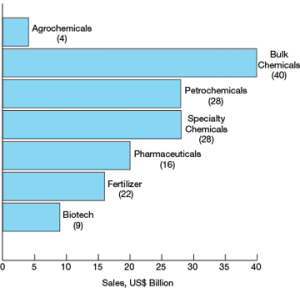
Outlook of Indian Chemical Industry in India
Chemicals are often called chemical substances that are forms of matter which have constant chemical compositions and characteristics properties. Chemical substances are not separated into compounds without the breakage of chemical bonds holding them together. The industry of chemicals comprises the companies that manufacture industrial chemicals. Central to the modern world economy it changes raw materials (oil, natural gas, air, water, metals, and minerals) into more than 70,000 various products. The industry of plastic contains a few overlaps, as some chemical companies produce plastics as well as chemicals. A lot of professionals are involved in the chemical industry comprising chemical engineers, chemists, and lab technicians. Till the year 2019, the chemical industry market comprises approx. 15% of the US manufacturing economic sector. One of the very first chemicals to be produced in large amounts through industrial processes was sulfuric acid.
Globally, the chemical industry is a complex and imperative part of the global economy and also to the supply chain network. The production of chemicals involves converting raw materials like fossil fuel, water, minerals, metal, and so on, into tens of thousands of different products that are central to modern life. By the year 2019, the total revenue of the chemical industry globally amounted to more than 4 trillion U.S. dollars.
Related projects: – Chemicals (Organic, Inorganic, Industrial) Projects
Classification of Chemical Industry

As said earlier, the chemical industry plays an important role in the global economy, over the 3 years 2021 to 2024 the industry is anticipated to rise in every segment, with overall industry growth anticipated to be 1.8 % in the year 2024. Basic chemicals are anticipated to see the highest growth of any chemical segment, at 2.1% is forecasted for 2024. Region-wise, Asia holds the biggest share of the global chemicals market by far. It has continuously accounted for more than 50% of the global chemical industry since 2012. Accordingly, the Asian chemical companies also hold prominent places; depending on net income, the world’s leading chemical company by 2019 was Japan’s Shin-Etsu chemical.
Related Books: – Chemical Technology (Organic, Inorganic, Industrial), Fine Chemicals
Market Share of Chemical Industry

- The important industrially and functionally significant chemical product categories include inorganic and organic chemicals, ceramics, polymers, elastomers, surfactants, acids, oleo chemicals, alcohols, dyes, bases, salts, alkalis, oils, colorants, esters, coatings, solvents, neutral gases, petrochemicals, process gases, and source gases. The total global shipment of chemical and chemical products shows trillions of dollars yearly and is represented by industries in practically every country of the world.
- Globally, the chemical distribution market size was valued at USD 239 billion in the year 2019 and is anticipated to grow at a CAGR of 5.3% from the year 2020 to 2027. Rising consumption of chemicals across end-use industries like construction, pharmaceutical, polymers, and resins coupled with high complexity in delivering like the customers is likely to push the opportunities for chemical distributors over the coming years.
- The chemical industry produces and supplies important raw material for companies in the industrial and manufacturing sectors. And the feedstocks are distributed to the end-users by 3rd party distributors or directly sold by manufacturers. Distribution of commodity and specialty chemicals by 3rd parties is expected to see significant growth and the sale of products directly to end-users owing to the outsourcing of value-added services, like logistics, packaging, blending, waste removal, inventory management, and imparting technical training.
Related Videos: – Chemicals (Organic, Inorganic, Industrial)
Conclusion
NIIR project consultancy services (NPCS) have written a book on “Modern Technology of Industrial Chemicals” where each segment of the industry is discussed and explained properly. A few of the topics that are covered in the book are the manufacturing of chemicals, purification of the product, and efficiency of the product. The major contents of the book are dye application, granulated fertilizers; purification includes dehydrogenation and further distillation. The book has proven to be a great help to new entrepreneurs, industrialists, research scholars, technical libraries, consultants, etc. to understand the industry correctly.
Noo_Art20





